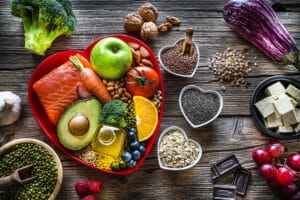There is a silent epidemic of iodine deficiency occurring in America. For several decades, the primary source of this critical mineral has been iodized table salt. Because of the mantra to avoid salt, people have stopped reaching for the salt shaker. Even if they defied the diet police and salted their food, researchers found in 2008 that less than half of iodized salts tested contained enough iodine to keep a person healthy. On top of that, there are trace amounts of iodine in the ever so popular sea salt along with the reduced consumption of fish that contain an ample supply of iodine because of the mercury. The answer to this perfect storm is an iodine supplement.
Why is iodine so necessary?
The thyroid is the master gland of the body which produces the thyroid hormone responsible for orchestrating many bodily processes. Iodine is critical to the synthesis of thyroid hormone. When iodine is deficient, so is thyroid hormone, and the result can be hypothyroidism, a disease characterized by poor functioning of body systems such as metabolism and immunity. Hypothyroidism can even jeopardize the health of the thyroid gland itself.
Iodine has a major impact on children and if deficient it can affect brain development and intellectual ability. A deficiency can cause mental retardation and cretinism, the severe stunting of physical and mental growth as well as deafness due to untreated congenital hypothyroidism. Childhood cancer can often be traced back to an iodine deficiency. Since 2001, there have been many studies documenting the importance of iodine during pregnancy, not only for the mother’s health, but especially for the cognitive and neurological development of the child.
Why do more women have hypothyroidism than men?
It is because the predominant female hormone known as estrogen inhibits the absorption of iodine. This happens in particular to women whose estrogen is mostly free and not bound to sex hormone binding globulin.
Iodine is also critical for detoxification.
It is needed to block toxins from accumulating in the thyroid gland, such as fluoride, perchlorate, and goitrogens in food. According to natural health expert Byron Richards, “problems with chemicals affecting the thyroid gland have been known for decades. A Russian study showed that general environmental pollution (of which the U.S. has plenty in every metropolitan area) significantly aggravates iodine lack (meaning pollution displaces iodine in the human body).”
Food sources of iodine
Is it possible to get the amount of iodine needed for optimal health from food sources? Most foods containing high levels of iodine are on today’s ‘no-no’ list. They include sea vegetables, scallops, cod, yogurt, shrimp, sardines, salmon, cow’s milk, eggs, and tuna.
Which iodine supplement is the right choice?
There seems to be two camps on the question of what iodine supplement is best, however, both camps agree that any iodine supplement should contain both iodine and iodide. The theory of the old guard is that the more iodine you take in, the better. Their goal is to bathe body tissues in iodine in hopes that some of it will be assimilated by the body. The forms they favor are Lugol’s and Iodoral, both of which contain potassium iodide and iodine.
The new guard says it is not how much iodine you consume that’s important – it’s how much you assimilate that counts. As a result, they have focused on developing a more highly bioavailable supplement known as Iosol. Iosol iodine is a proprietary formulation that has been widely used for decades because of its solubility in water. It is this feature that increases its bioavailability, and makes it the better choice.
The iodine in Iosol comes from kelp, which is naturally in the form of potassium iodide. Potassium iodide, however, is not very soluble in water and may be difficult to assimilate. For example, if you put a drop of potassium iodide on your shirt, it will permanently stain red. In high doses, potassium iodide has been shown to congest the thyroid gland and ultimately lead to a disease known as Hashimotos thyroiditis.
To create Iosol, the potassium is cleaved and pure unbound iodine crystals are formed. Added to that is ammonium iodide, a form that readily dissolves in water, producing a free iodide ion which is the most compatible for human metabolism.
[dt_divider style=”thin” /]
For more information:
http://www.lifeextension.com/magazine/2011/10/The-Silent-Epidemic-of-Iodine-Deficiency/Page-01
http://www.livestrong.com/article/253747-does-sea-salt-have-iodine-in-it/
http://www.wellnessresources.com/products/iosol_iodine.php
http://www.whfoods.com/genpage.php?tname=nutrient&dbid=69




